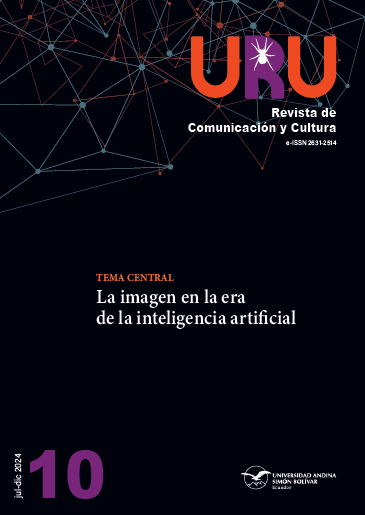Coevolution and Co-Creation: An Ecological View of Hybrid Intelligence in the Preproduction Phase of Audiovisual Media Páginas
DOI:
https://doi.org/10.32719/26312514.2024.10.6Keywords:
Artificial intelligence, film industry, technology, media ecology, hybrid intelligence, coevolution, artistic creation, digitizationAbstract
This article examines the emerging relationship between humans and artificial intelligence (AI) in the preproduction phase of the audiovisual media industry. In this endeavor, adopting an interdisciplinary perspective grounded in media ecology theory and actor–network theory (ANT), two contrasting scenarios of this interaction are explored. On the one hand, mutualism, where humans and artificial species collaborate to improve the efficiency and quality of the creative process, is presented through the analysis of ScriptBook and Cinelytic, two of the most important used AI tools in the film industry. In addition, the dystopian threat is raised, where AI could replace human scriptwriters in the audiovisual media ecosystem, as illustrated by the strike of the Hollywood producers’ and screenwriters’ unions in 2023. These scenarios raise questions about the future of the industry and the coevolution between humans and AI through the concept of mutation. Emphasis is placed on the need to adapt to these transformations,
recognizing the fundamental role of researchers and society in monitoring the relationship between humans and AI to understand its potential for co-creation and coevolution. Finally, the importance of agile adaptation to a constantly changing media ecosystem is underscored as an essential task to fully leverage the potential of hybrid intelligence and ensure the survival of the human species in this new technological paradigm.
Downloads
References
Aguiar, Diego. 2003. “Determinismo tecnológico versus determinismo sociológico: Una revisión conceptual crítica para la superación de estos abordajes”. Ponencia realizada en las III Jornadas de Sociología de la Universidad Nacional de La Plata, 10 al 12 de diciembre. https://tinyurl.com/y9uek2kd.
Anantrasirichai, Nantheera, y David Bull. 2022. “Artificial Intelligence in the Creative Industries: A Review”. Artificial Intelligence Review 55: 589-656. https://tinyurl.com/3pdnx6bt. DOI: https://doi.org/10.1007/s10462-021-10039-7
Andriasyan, Siranush. 2024. “How Artificial Intelligence Is Used in the Film Industry”. SmartClick. Accedido 19 de abril. https://tinyurl.com/yc65nr2e.
Baricco, Alessandro. 2008. Los bárbaros: Ensayo sobre la mutación. Barcelona: Anagrama.
—. 2018. The Game. Barcelona: Anagrama. Edición para Kindle.
Bolter, David, y Richard Grusin. 2011. “Inmediatez, hipermediación, remediación”. CIC. Cuadernos de Información y Comunicación 16: 29-57. https://doi.org/10.5209/rev_CIYC.2011.v16.2. DOI: https://doi.org/10.5209/rev_CIYC.2011.v16.2
Canudo, Ricciotto. 1911. “Manifiesto de las siete artes”. U-Cursos. https://tinyurl.com/2s3fj4ns.
Chow, Pei-Sze. 2020. “Ghost in the (Hollywood) Machine: Emergent Applications of Artificial Intelligence in the Film Industry”. NECSUS. European Journal of Media Studies 9 (1): 193-214. http://dx.doi.org/10.25969/mediarep/14307.
Darcy, Oliver. 2023. “Cómo el histórico acuerdo de los guionistas de Hollywood con los estudios sentaría un precedente en la batalla contra la inteligencia artificial”. CNN. 28 de septiembre. https://tinyurl.com/ync4udd5.
Dellermann, Dominik, Philipp Ebel, Matthias Söllner y Jan Marco Leimeister. 2019. “Hybrid Intelligence”. Business & Information Systems Engineering 61: 637-43. https://doi.org/10.1007/s12599-019-00595-2 DOI: https://doi.org/10.1007/s12599-019-00595-2
Donnelly, Jim. 2023. “How Artificial Intelligence Helps (and Hurts) Filmmaking”. Massive. 24 de enero. https://tinyurl.com/ymhcecv8.
Ehrenfeld, John, y Marian Chertow. 2002. “Industrial Symbiosis: The Legacy of Kalundborg”. En A Handbook of Industrial Ecology, editado por Robert Ayres y Leslie Ayres, 334-50. Cheltenham, UK:Edward Elgar. https://tinyurl.com/4rpyedp9. DOI: https://doi.org/10.4337/9781843765479.00038
Fagerjord, Anders, y Tanja Storsul. 2007. “Questioning Convergence”. En Ambivalence Towards Convergence: Digitalization and Media Change, editado por Tanja Storsul y Dagny Stuedahl, 19-31. Gotemburgo:Nordicom. https://tinyurl.com/4zw9cnd3.
Google. 2024. “¿Qué es la inteligencia artificial o IA?”. Google Cloud. Accedido 21 de abril. https://tinyurl.com/ykefd53f.
Gubern, Román. 2014. Historia del cine. Barcelona: Anagrama.
Izquierdo, Jessica. 2007. “Distribución y exhibición cinematográfica en España: Un estudio de situación del negocio en la transición tecnológica digital”. Tesis doctoral, Universidad Jaume I, España. https://tinyurl.com/34eueu8d.
Krinkin, Kirill, Yulia Shichkina y Andrey Ignatyev. 2022. “Co-Evolutionary Hybrid Intelligence Is a Key Concept for the World Intellectualization”. Kybernetes 52 (9): 2907-23. https://doi.org/10.1108/K-03-2022-0472. DOI: https://doi.org/10.1108/K-03-2022-0472
Londoño, Cristian. 2017. “El objeto de la profesión del guionista”. Revista Anales 1 (374): 35-40. https://tinyurl.com/3vvs8b94. DOI: https://doi.org/10.29166/anales.v1i374.1378
Macrotrends. 2024. “Warner Bros Discovery Revenue 2010-2024 | WBD”. Macrotrends. Accedido 24 de abril. https://tinyurl.com/ycyb6zyn.
Oracle. 2024. “¿Qué es la IA? Conoce la inteligencia artificial”. Oracle Cloud Infrastructure. Accedido 21 de abril. https://tinyurl.com/yf7mm2ps.
Orús, Abigail. 2023. “Industria del cine mundial: Datos estadísticos”. Statista. 31 de diciembre. https://tinyurl.com/mw3zt9en.
Pico, Raquel. 2023. “¿Por qué es importante la huelga de actores y guionistas?”. Ethic. 25 de julio. https://tinyurl.com/2ppamkwf.
Pozas, María de los Ángeles. 2015. “En busca del actor en la teoría del actor red”. Ponencia presentada en el I Congreso Latinoamericano de Teoría Social, Buenos Aires, 9 a 21 de agosto. https://tinyurl.com/bdzef2wc.
Salas, Bertold. 2018. “La intermedialidad: Las oportunidades y los riesgos de un concepto en boga”. Revista Estudios, núm. extra 1. https://tinyurl.com/jmuhppkp.
Scolari, Carlos. 2015. Ecología de los medios: entornos, evoluciones e interpretaciones. Barcelona: Gedisa.
ScriptBook. 2024. “The Proof Is in the Pudding: Projects Analyzed for Our Clients in Pre-Production Stage”. ScriptBook. Accedido 19 de abril. https://tinyurl.com/mrxx22rh.
Strate, Lance. 2018. “The Medium Is the Membrane”. ETC.: A Review of General Semantics 75 (3-4). https://tinyurl.com/yu3y3wcb.
Tene?s, Eduardo. 2023. “Impacto de la inteligencia artificial en las empresas”. Trabajo de fin de grado, Universidad Politécnica de Madrid, España. https://tinyurl.com/36srcj3u.
Universidad de Navarra. 2023. “Parasitismo”. Clínica Universidad de Navarra. https://tinyurl.com/3jdp4yyx.
Wilkinson, Alissa. 2020. “Hollywood Is Replacing Artists with AI. Its Future Is Bleak”. Vox. 29 de enero. https://tinyurl.com/32twuvu6.
Yao, Yiyu. 2022. “Human-Machine Co-Intelligence through Symbiosis in the SMV Space”. Applied Intelligence 53: 2777-97. https://doi-org.ezproxy.eafit.edu.co/10.1007/s10489-022-03574-5. DOI: https://doi.org/10.1007/s10489-022-03574-5
Zeilig, Hannah, Julian West y Millie van der Byl Williams. 2018. “Co-Creativity: Possibilities for Using the Arts with People with a Dementia”. Quality in Ageing and Older Adults 19 (2): 135-45. https://doi.org/10.1108/QAOA-02-2018-0008. DOI: https://doi.org/10.1108/QAOA-02-2018-0008
Published
How to Cite
Issue
Section
License
Copyright (c) 2024 Uru: Revista de Comunicación y Cultura

This work is licensed under a Creative Commons Attribution-NonCommercial-ShareAlike 4.0 International License.
ASSIGNMENT OF RIGHTS, DECLARATION OF CONFLICT OF INTEREST AND DISSEMINATION
The authors who publish in this journal accept the following conditions:
- Authors retain copyright and grant the journal the right of first publication, with the work registered under the Creative Commons Attribution-NonCommercial-ShareAlike 4.0 License, which allows sharing, adapting and attributing the work (see: Open Access Policies).
- Authors can make other independent and additional contractual agreements for the distribution of the article published in this journal (e.g., include it in an institutional repository or publish it in a book) as long as they expressly indicate that the article was published for the first time in Uru: Revista de Comunicación y Cultura. In the case of reproduction, a note similar to the following must be included: This text was originally published in the journal Uru: Revista de Comunicación y Cultura N ° -, year of publication.
- Authors are encouraged to publish their work on the Internet (e.g. on institutional or personal pages) in the final version published by Uru: Revista de Comunicaicón y Cultura as it may lead to a wider and faster dissemination of the published work.








